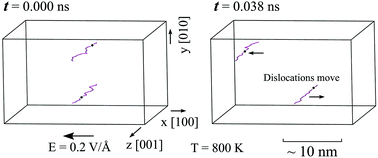Molecular dynamics discovery of an extraordinary ionic migration mechanism in dislocation-containing TlBr crystals
Abstract
TlBr can surpass CZT as the leading semiconductor for γ- and X-radiation detection. Unfortunately, the optimum properties of TlBr quickly decay when an operating electrical field is applied. Quantum mechanical studies indicated that if this property degradation comes from the conventional mechanism of ionic migration of vacancies, then an unrealistically high vacancy concentration is required to account for the rapid aging of TlBr seen in experiments. In this work, we have applied large scale molecular dynamics simulations to study the effects of dislocations on ionic migration of TlBr crystals under electrical fields. We found that electrical fields can drive the motion of edge dislocations in both slip and climb directions. These combined motions eject enormous vacancies in the dislocation trail. Both dislocation motion and a high vacancy concentration can account for the rapid aging of the TlBr detectors. These findings suggest that strengthening methods to pin dislocations should be explored to increase the lifetimes of TlBr crystals.



 Please wait while we load your content...
Please wait while we load your content...
